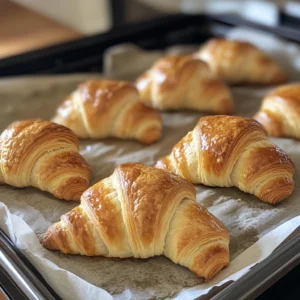Creating the perfect croissant is both an art and a science. In this comprehensive guide, we will explore every detail—from the rich history and cultural significance of these flaky pastries to an in-depth, step-by-step process that you can confidently follow in your own kitchen. Whether you’re a seasoned baker or a passionate beginner, this article is designed to help you achieve bakery-quality croissants at home.
In today’s culinary landscape, understanding traditional croissant making is essential. For additional insights into professional baking techniques, check out Advanced Pastry Techniques.
This external resource offers invaluable methods to refine your skills and bring a professional touch to your baking. Moreover, if you’re curious about how the chemistry of butter influences your dough, read Understanding the Science of Butter in Pastry for a deep dive into ingredient interactions.
Internal Tip: For more detailed instructions on creating your pastry, explore our Step-by-Step French Toast Guide for extra breakfast inspiration.
Introduction to Croissant Culture

The croissant is much more than just a pastry; it is a true symbol of French culinary excellence. Originating from a rich European tradition, the croissant has become an icon of refined taste and artisanal craftsmanship.
A Brief History
The croissant finds its roots in European baking traditions. While many believe that it was invented in France, some historical accounts trace its origins back to the Austrian kipferl. Over the centuries, the recipe evolved through the creative innovations of French bakers who perfected the art of lamination. Today, the croissant stands as a testament to the enduring legacy of European patisserie, symbolizing both the sophistication and simplicity of French cuisine.
Purpose of This Guide
This guide is intended to demystify the process of making croissants at home. We will cover everything from selecting high-quality ingredients and essential equipment to understanding the scientific principles behind laminated dough. Additionally, we provide troubleshooting tips and creative variations to help you overcome common challenges and add your personal touch to this classic recipe.
What You Will Learn
- The historical and cultural context of the croissant.
- Detailed, step-by-step instructions on preparing, laminating, shaping, and baking the perfect croissant.
- Practical tips for troubleshooting common issues such as dough not rising or butter leakage.
- Creative variations, including both sweet and savory options, to suit your taste and dietary needs.
The Rich History and Evolution of the Croissant
Understanding the history behind the croissant can deepen your appreciation for its intricate preparation process and delicious outcome.
Historical Origins
The modern croissant evolved from the kipferl, an Austrian pastry that dates back to the 13th century. Over time, the French adapted this pastry by introducing the technique of dough lamination, which involves folding layers of butter into the dough to create a light, airy, and flaky texture. This method revolutionized pastry making and helped establish the croissant as a staple of French cuisine.
Cultural Significance
Today, the croissant is synonymous with French culinary tradition and is enjoyed worldwide. In France, croissants are a morning ritual, typically served with coffee or hot chocolate. The delicate balance of flavor, texture, and aroma makes the croissant a culinary masterpiece that transcends cultural boundaries.
Evolution of Techniques
From the early days of hand-rolling dough to modern mechanized production, the technique of lamination has undergone significant refinements. Traditional methods emphasize patience, precision, and attention to detail—qualities that remain essential for producing high-quality croissants. Modern innovations have made some aspects of the process more efficient, yet the fundamental principles of layering and cold working the dough remain unchanged.
Learn how traditional methods still influence modern kitchens by visiting Discover Plymouth Cheese History.
Essential Ingredients and Equipment

A successful croissant recipe begins with selecting high-quality ingredients and the right equipment. The perfect balance of these elements is crucial for achieving that characteristic flaky texture and rich flavor.
Key Ingredients
- Flour: Use high-protein flour to ensure optimal gluten development. This helps in creating a strong, elastic dough that can support multiple layers.
- Butter: High-quality, unsalted butter is essential. The butter must be cold and have a high fat content to create distinct layers during lamination.
- Yeast, Sugar, Salt, and Water: These ingredients work together to create the right environment for the dough to rise and develop flavor. Fresh, active yeast is key to achieving the desired lightness in your croissants.
Necessary Equipment
- Rolling Pin & Dough Scraper: These tools are vital for rolling out the dough evenly and keeping your work surface clean.
- Baking Tray & Temperature-Controlled Environment: A proper baking tray ensures even heat distribution, while a cool, controlled environment is necessary during the lamination process.
- Additional Tools: For example, maintaining sharp kitchen tools is important; learn how with our guide How to Sharpen a Knife: A Comprehensive Guide.
Tips and Substitutions
- Experiment with alternative flours or dairy-free butter if needed, especially if you have dietary restrictions.
- Sourcing premium ingredients from reputable suppliers can elevate the quality of your final product.
- To optimize your kitchen setup, explore modern cooking aids such as pressure cookers; see What is a Pressure Cooker Best For?.
The Science Behind the Perfect Croissant
Achieving a beautifully flaky croissant requires a deep understanding of the science behind laminated dough. The transformation of simple ingredients into a multi-layered pastry is a fascinating process that involves both art and chemistry.
Lamination Process
Lamination is the heart of croissant making. This technique involves enveloping a block of cold butter within a dough, then repeatedly rolling, folding, and chilling the dough. Each fold creates additional layers, which, when baked, separate and puff up to form the signature flaky texture.
Role of Butter and Gluten
- Butter plays a dual role: it adds flavor and creates layers by interrupting gluten formation. When the dough is baked, the water in the butter turns to steam, pushing the layers apart.
- Gluten, a network of proteins formed when flour is mixed with water, provides the structure necessary to support these layers. However, too much gluten can make the pastry tough, so it is important to handle the dough gently and avoid overmixing.
Temperature and Timing
Maintaining the right temperature throughout the process is crucial. The dough and butter must remain cold to prevent the butter from melting and blending with the dough prematurely. Proper chilling between folds allows the gluten to relax, ensuring that the layers remain distinct during baking.
Quick Tips:
- Cold Dough Handling: Always keep your ingredients refrigerated until they are ready to be used.
- Consistent Rolling: Ensure that the dough is rolled evenly to maintain uniform layers.
- Multiple Folds: Repeating the folding process at least three to four times is essential for building up enough layers for maximum flakiness.
For a deeper understanding of these techniques, visit Understanding Laminated Dough.
Detailed Step-by-Step Process – Part 1
Let’s begin the process of making croissants by focusing on the initial steps. This phase lays the foundation for the delicious pastry that follows.
Mixing the Dough
Start by combining your key ingredients:
- Ingredients: Flour, yeast, sugar, salt, and water.
- Process: Mix until you achieve a smooth, cohesive dough. Use a stand mixer or work by hand—whichever method you prefer. Be cautious not to overmix, as this can lead to a tough dough that lacks the desired lightness.
Tips:
- Mix until the ingredients are just incorporated to preserve the dough’s delicate structure.
- Allowing the dough to rest briefly after mixing helps the flour fully hydrate and the gluten to begin developing.
Initial Rest and Shaping
Once your dough is mixed, cover it and allow it to rest in a cool environment. This resting period is essential as it gives the gluten time to relax, making the dough easier to roll out later.
Incorporating the Butter Block
Prepare a cold, rectangular block of butter. The butter should be firm yet pliable—if it’s too hard, it will break into pieces; if too soft, it will blend with the dough. Gently place the butter onto the dough and begin incorporating it evenly. This step is crucial, as an even distribution of butter will create consistent layers in the final pastry.
First Rolling and Folding
Roll the dough out into a large rectangle. Perform the first fold by bringing the top third down over the center and then folding the bottom third up over that. This is often referred to as a letter fold. Once folded, chill the dough for at least 30 minutes to allow the butter to firm up again.
Detailed Step-by-Step Process – Part 2
After establishing the base, continue with the advanced steps required to perfect your croissant dough.
Subsequent Folds
After the initial fold and chill, repeat the rolling and folding process two to three more times. This ensures the dough develops numerous thin layers. Always keep the dough refrigerated between folds to prevent the butter from melting and blending into the dough.
Shaping the Croissants
Once the final fold is complete, roll the dough into a large, even rectangle. Using a sharp knife or a dough cutter, slice the dough into uniform triangles. Carefully roll each triangle from the base towards the tip to form the classic crescent shape. The rolling should be gentle to maintain the integrity of the layers.
Proofing
After shaping, place the croissants on a parchment-lined baking tray. Allow them to proof (rise) in a warm, humid environment until they nearly double in size. Proper proofing is essential for developing a light, airy interior once baked.
Baking and Finishing Techniques

The final stage of the croissant-making process is baking and finishing. This is where the transformation happens, and your croissants take on their signature golden-brown, flaky appearance.
Oven Preparation
Preheat your oven to 375°F–400°F (190°C–205°C). An evenly preheated oven is crucial for ensuring that the croissants bake uniformly.
Baking
Arrange the proofed croissants on a baking tray lined with parchment paper. Place the tray in the oven and bake for 15–20 minutes, or until the croissants have a uniform, golden-brown finish. Keep an eye on them during the final minutes to avoid overbrowning.
Finishing Touches
Once out of the oven, immediately brush the croissants with an egg wash if you desire an extra glossy finish. Allow them to cool on a wire rack to maintain their crisp texture. For a modern twist on crisping up your recipes, explore The Comprehensive Guide to Airfryers Technology.
For further advice on perfecting your baking process, check out our Baking Basics.
Creative Variations and Flavored Croissants
Once you’ve mastered the basic recipe, you can start experimenting with creative variations to suit your taste and dietary needs.
Sweet Variations
- Chocolate Croissants: Incorporate finely chopped dark chocolate or a spread of chocolate hazelnut into the dough before rolling.
- Almond Croissants: Add almond paste and sprinkle sliced almonds on top before baking.
- Fruit-Filled Croissants: Include fruit jams or compotes between the layers, and finish with a light dusting of powdered sugar.
Savory Options
- Cheese & Herb Croissants: Mix grated cheese and finely chopped herbs into the dough or use them as a filling.
- Turkey ham and Cheese Croissants: Add thin slices of ham and your favorite cheese between the layers for a hearty breakfast treat.
Dietary Alternatives
- Gluten-Free Options: Substitute regular flour with a gluten-free blend designed for pastries.
- Dairy-Free Variations: Use a dairy-free butter alternative if you have lactose intolerance or prefer vegan recipes.
For additional creative inspirations, visit Saffron Recipes: A Guide to Cook.
Troubleshooting Common Issues
Even the most experienced bakers encounter challenges. Here are some common issues and practical solutions to keep your process on track:
Dough Not Rising
- Cause: This may be due to inactive yeast or a dough that is too cold.
- Solution: Ensure your yeast is fresh and active, and let the dough rest in a warm environment during proofing.
Butter Leakage
- Cause: Butter can begin to melt and seep out if the dough gets too warm.
- Solution: Always keep your ingredients and dough cold. Work quickly and chill the dough between folds to maintain the integrity of the butter layers.
Dense or Uneven Layers
- Cause: Overworking the dough or uneven rolling can result in dense layers.
- Solution: Roll the dough evenly and avoid excessive kneading after the initial mixing. Ensure each fold is done with care, and allow proper resting time between folds.
Frequently Asked Questions (FAQs)
Here are some answers to common questions about making the perfect croissant:
What is the best type of butter for croissants?
Use high-quality, unsalted butter to achieve the best flavor and texture. The butter should be firm and cold for optimal layering.
How many folds are needed for a perfect croissant?
Typically, three to four folds are sufficient to create a flaky texture. Each fold adds layers that help the pastry puff up beautifully.
Can I make croissants ahead of time?
Yes, you can freeze the shaped dough before proofing. Once frozen, thaw them in a cool environment and then proceed with proofing before baking.
Why isn’t my dough flaky enough?
This may be due to using ingredients that are too warm or not folding the dough enough times. Ensuring that both your dough and butter remain cold throughout the process is key.
How should I store croissants?
Store baked croissants in an airtight container at room temperature for a day or two. For longer storage, freeze them and reheat in the oven before serving.
What are common mistakes in croissant making?
Overworking the dough, not keeping the ingredients cold, and uneven rolling can compromise the final product. Always follow the process closely, and be patient during each resting phase.
Conclusion and Final Thoughts
Mastering the croissant recipe is a rewarding journey that blends tradition, science, and creativity. With practice and attention to detail, you can create croissants that rival those from the finest French bakeries—all from the comfort of your own kitchen.
Review the Process
- Emphasize quality ingredients and precise techniques throughout the process.
- Understand the importance of temperature control, proper folding, and adequate resting times.
Embrace Experimentation
- Don’t hesitate to try creative variations, whether sweet or savory, to personalize your croissants.
- Experiment with different fillings and flavorings to develop your signature style.
Keep Learning
- Regular practice is the key to perfecting your craft.
- Continuously seek out new techniques and tips from expert resources and fellow bakers.
For more delightful breakfast inspirations and recipes, explore our post on The Ultimate Pancakes Recipe: A Guide.
By following this comprehensive guide, you are now well-equipped to create exquisite croissants that showcase both the art and science of French patisserie. Enjoy the process, experiment boldly, and share your delicious creations with friends and family.
Bon appétit !

